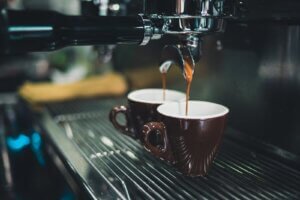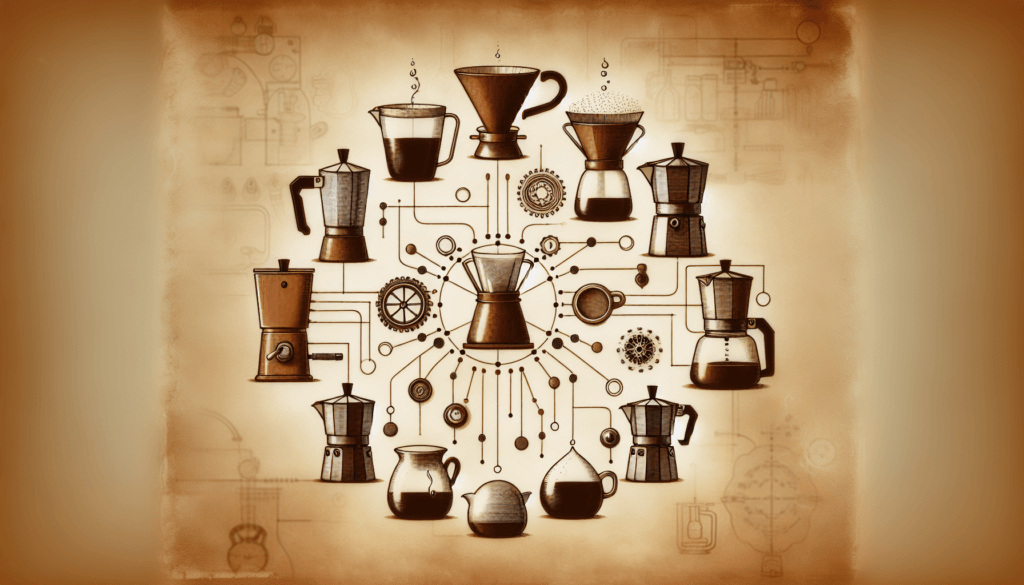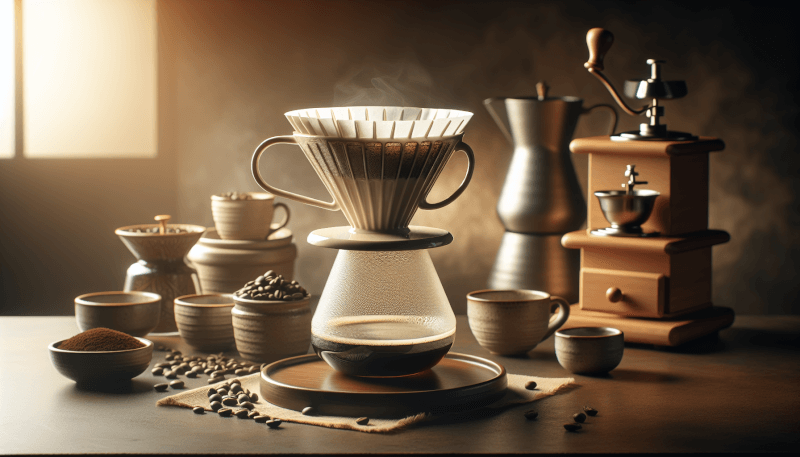Different Coffee Brewing Techniques Explained – Coffee enthusiasts have always been intrigued by the various methods and techniques used to brew the perfect cup of joe. Whether you’re a fan of the classic drip coffee maker or you’re looking to explore the world of pour-over or French press, this article has got you covered. Join us as we dive into the fascinating world of different coffee brewing techniques. From the nuances of espresso brewing to the simplicity of cold brew, we’ll explore each method and help you unravel the secrets behind that delicious cup of morning coffee. So grab your favorite mug and get ready to discover a whole new world of coffee brewing!

1. Different Coffee Brewing Techniques Explained – Drip Brewing
1.1 Basic Description
Drip brewing is one of the most common methods used to brew coffee. It involves pouring hot water over ground coffee beans and allowing the water to pass through a filter, extracting the flavors and aromas of the coffee. This brewing method is widely used in households and is known for producing a smooth and consistent cup of coffee.
1.2 Process
The process of drip brewing is quite simple. First, you need a drip coffee maker, which consists of a water reservoir, a heating element, and a filter basket. Fill the water reservoir with the desired amount of water and add coffee grounds to the filter basket. The water is then heated and dripped over the coffee grounds, passing through the filter and into a coffee pot or carafe.
1.3 Pros and Cons
Drip brewing has several advantages. It is convenient and easy to use, making it perfect for everyday brewing. The coffee produced is usually consistent in flavor and strength, providing a satisfying cup each time. Drip brewers are also available in a range of sizes and styles to suit different needs.
However, drip brewing may not be the best option for those seeking a more complex and nuanced flavor profile. The extraction process in drip brewing is often quicker, resulting in a lighter-bodied coffee compared to other methods. Additionally, some coffee enthusiasts argue that the paper filters used in drip brewing may absorb certain flavorful oils, resulting in a less aromatic cup of coffee.
2. French Press
2.1 Basic Description
The French press, also known as a press pot or plunger pot, is a popular brewing method that allows for full immersion of the coffee grounds in water. It consists of a cylindrical glass or stainless steel container with a fine mesh plunger. This technique is known for producing a bold and robust cup of coffee.
2.2 Process
To brew coffee using a French press, start by adding coarsely ground coffee into the empty container. Then, pour hot water over the coffee, ensuring that all the grounds are saturated. Place the lid on the French press, with the plunger raised, and let the coffee steep for about four minutes. Afterward, slowly press down the plunger to separate the brewed coffee from the grounds.
2.3 Pros and Cons
The French press offers several advantages. It allows for maximum extraction of flavors and oils from the coffee grounds, resulting in a rich and full-bodied cup. This brewing method is also versatile, as it can be used to brew both regular and stronger coffee by adjusting the steeping time and coffee-to-water ratio.
However, the French press requires careful attention to achieve optimal results. The use of a metal mesh filter instead of paper filters allows some sediments to pass through, which can create a slightly gritty texture in the coffee. Cleaning a French press can also be more involved compared to other brewing methods, as the mesh filter needs to be thoroughly rinsed and scrubbed to remove any residual coffee oils.

3. Pour Over
3.1 Basic Description
Pour over brewing is a manual coffee brewing technique that involves pouring hot water over coffee grounds placed in a filter. This method allows for precision and control over the brewing process, resulting in a flavorful and well-balanced cup of coffee.
3.2 Process
To brew coffee using the pour over method, you will need a pour over dripper, a paper or metal filter, and a heat-resistant vessel to catch the brewed coffee. Start by placing the filter in the dripper and rinsing it with hot water to remove any paper taste. Then, add your desired amount of coffee grounds to the filter and slowly pour hot water over them in a circular motion. The water will pass through the filter and extract the flavors of the coffee. Repeat the pouring process until you have brewed the desired amount of coffee.
3.3 Pros and Cons
Pour over brewing offers a great deal of control over the brewing variables, such as water temperature, pour rate, and bloom time. This control allows you to experiment and fine-tune your brew to achieve the desired flavor profile. The paper filters used in pour over brewing also help in removing any sediments and oils, resulting in a clean and crisp cup of coffee.
On the downside, pour over brewing can be time-consuming and requires a certain level of skill and practice to master. Additionally, the pour over method is best suited for brewing small quantities of coffee, making it less convenient for larger servings or multiple cups.
4. Espresso
4.1 Basic Description
Espresso is a concentrated form of coffee that is brewed by forcing pressurized hot water through finely ground coffee beans. This brewing method produces a strong and intense shot of coffee with a rich crema on top.
4.2 Process
To brew espresso, you need an espresso machine equipped with a portafilter, which holds the coffee grounds. First, grind the coffee beans to a fine consistency and distribute the grounds evenly in the portafilter. Tamp the grounds down firmly to ensure even extraction. Place the portafilter back into the espresso machine and start the brewing process. Hot water is then forced through the grounds under high pressure, extracting the flavors and oils quickly.
4.3 Pros and Cons
Espresso brewing offers a unique and intense coffee experience. The concentrated shot of espresso is the base for various coffee-based beverages, such as lattes, cappuccinos, and macchiatos. The high-pressure extraction process results in a strong and robust flavor profile, with the characteristic crema adding a velvety texture to the coffee.
However, brewing espresso requires more specialized equipment and knowledge compared to other brewing methods. Espresso machines can be expensive and may require regular maintenance and cleaning. Achieving the perfect espresso shot also requires skill in grinding, tamping, and controlling the extraction process, making it more challenging for beginners.

5. Aeropress
5.1 Basic Description
The Aeropress is a versatile and portable brewing device that combines elements of both immersion and pressure brewing. It allows for a quick and efficient brewing process, producing a clean and flavorful cup of coffee.
5.2 Process
To brew coffee using the Aeropress, start by placing a paper filter inside the filter cap and rinsing it with hot water. Attach the filter cap to the brewing chamber and place it on top of a mug or vessel. Add your desired amount of coffee grounds to the chamber, followed by hot water. Stir the coffee and water mixture for a few seconds, allowing it to steep. Then, securely attach the plunger and gently press down to extract the brewed coffee into the mug.
5.3 Pros and Cons
The Aeropress offers several advantages, especially for those who value convenience and flexibility. It is compact and portable, making it a great option for traveling or brewing coffee on the go. The immersion and pressure brewing techniques used in the Aeropress result in a clean and well-extracted cup of coffee, with the ability to easily adjust brew time and water temperature to suit personal preferences.
On the downside, the Aeropress is limited in terms of batch size, as it is designed for brewing a single cup of coffee at a time. The paper filters used in the Aeropress also remove some of the coffee oils, which can result in a slightly lighter-bodied cup compared to other brewing methods.
6. Turkish
6.1 Basic Description
Turkish coffee, also known as “Turk Kahvesi,” is a traditional method of coffee preparation that originated in the Middle East. This brewing method involves boiling finely ground coffee beans in water and often incorporates spices such as cardamom, creating a strong and aromatic cup of coffee.
6.2 Process
To brew Turkish coffee, you need a cezve, a small, long-handled pot specifically designed for this method. Start by adding finely ground coffee and water to the cezve, using a coffee-to-water ratio based on your desired strength. Add any desired spices, such as cardamom or cinnamon, and place the cezve on low heat. Stir the mixture gently until it starts to foam and rise. Just before it reaches a rolling boil, remove it from the heat and allow the grounds to settle. Repeat this process two more times, and then pour the coffee into small cups, ensuring that the grounds stay at the bottom of the cezve.
6.3 Pros and Cons
Turkish coffee offers a unique and rich brewing experience. The intense flavors and aroma, along with the cultural significance, make it a popular choice for coffee enthusiasts. The addition of spices like cardamom adds complexity and depth to the coffee.
However, Turkish coffee may not be suitable for those who prefer a milder or less concentrated cup of coffee. The fine grinding required for Turkish coffee can make it challenging to achieve a consistent texture, and the brewing process can take longer compared to other methods. Cleaning the cezve and removing any leftover coffee grounds can also be more time-consuming.

7. Cold Brew
7.1 Basic Description
Cold brew is a brewing method that involves steeping coffee grounds in cold water for an extended period, usually overnight. This technique produces a smooth and less acidic cup of coffee, perfect for those who prefer a chilled and refreshing beverage.
7.2 Process
To make cold brew coffee, start by coarsely grinding coffee beans and placing them in a container. Add cold water to the container and stir gently to ensure all the grounds are wet. Cover the container and let it steep in the refrigerator for around 12 to 24 hours, depending on the desired strength. Once steeping is complete, strain the coffee through a fine mesh sieve or a coffee filter to remove the grounds. The resulting concentrate can be diluted with water or served over ice.
7.3 Pros and Cons
Cold brew coffee has gained popularity due to its smooth and low-acidity nature. The slow extraction process in cold water results in a mellow and less bitter cup. It can be stored in the refrigerator for several days, making it convenient for enjoying iced coffee without the need for immediate brewing.
However, cold brew coffee can be time-consuming to prepare, as it requires a long steeping time. The resulting concentrate is also highly concentrated, requiring dilution with water or milk to achieve the desired strength. Additionally, the flavor profile of cold brew coffee may not suit everyone’s taste preferences, particularly those who prefer a brighter and more acidic coffee.
8. Siphon
8.1 Basic Description
The siphon brewing method, also known as vacpot or syphon, combines the principles of full immersion and vapor pressure to extract the flavors of coffee. It involves two separate chambers, with one containing water and the other coffee grounds. As the water heats up, vapor pressure pushes the water into the upper chamber, mixing with the coffee grounds. Once removed from the heat, a vacuum effect is created, drawing the brewed coffee back into the lower chamber.
8.2 Process
To brew coffee using a siphon, start by adding water to the bottom chamber and coffee grounds to the upper chamber, which is fitted with a filter. As the water heats up, it will rise to the upper chamber and mix with the coffee grounds. Stir the mixture to ensure even extraction. Once the brewing time is complete, remove the siphon from the heat source. As the vapor cools, a vacuum effect is created, drawing the brewed coffee back down to the lower chamber. Carefully separate the chambers and pour the coffee into serving vessels.
8.3 Pros and Cons
Siphon brewing offers a unique and visually appealing brewing experience. The combination of immersion and vapor pressure allows for a thorough extraction of the coffee flavors and aromas. The glass chambers of the siphon also add an element of elegance and drama to the brewing process, making it a great choice for coffee enthusiasts who value aesthetics.
However, the siphon brewing method can be more involved and time-consuming compared to other brewing techniques. The setup requires specialized equipment, and the brewing process itself may require some practice to achieve consistent results. Cleaning the siphon can also be more challenging, as the glass chambers and filter need to be thoroughly washed to remove any residual coffee oils.
9. Moka Pot
9.1 Basic Description
The Moka pot, also known as a stovetop espresso maker, is a brewing device that uses steam pressure to brew coffee. It consists of a bottom chamber for water, a middle chamber for coffee grounds, and a top chamber for the brewed coffee.
9.2 Process
To brew coffee using a Moka pot, start by adding water to the bottom chamber up to the valve. Insert the funnel-shaped filter into the middle chamber and fill it with finely ground coffee. Carefully assemble the different parts of the Moka pot, ensuring a tight seal. Place the pot on the stovetop over medium heat. As the water boils, steam pressure builds up, forcing the hot water through the coffee grounds and into the top chamber. Once all the brewed coffee has collected in the top chamber, remove the Moka pot from the heat.
9.3 Pros and Cons
Moka pots offer a convenient and affordable way to brew coffee with a flavor profile similar to espresso. The steam pressure in the Moka pot produces a strong and bold cup of coffee. The compact size also makes it suitable for small kitchens or travel.
However, it is important to note that Moka pots do not achieve true espresso as they operate at lower pressures. The brewing process can also be finicky, requiring attention to heat control to prevent over-extraction or bitter flavors. Cleaning a Moka pot can also be more involved due to its multi-piece construction.
10. Single-Serve Brewing
10.1 Basic Description
Single-serve brewing methods, such as pod systems or single-serve coffee makers, have gained significant popularity in recent years. These methods allow for quick and convenient brewing of a single cup of coffee without the need for measuring or grinding coffee beans.
10.2 Process
The process of single-serve brewing varies depending on the specific method or system used. In pod systems, pre-packaged coffee pods or capsules are inserted into the brewer, which punctures the pod and forces hot water through it. The brewed coffee then flows directly into a cup. Single-serve coffee makers often use proprietary coffee pods or cups that contain the right amount of coffee for a single serving. The cups are placed in the machine, and hot water is brewed through them, directly into a cup.
10.3 Pros and Cons
Single-serve brewing methods offer unparalleled convenience and simplicity. The pre-packaged pods or cups eliminate the need for measuring or grinding coffee, making it a time-saving option for busy individuals. Additionally, the single-serve format allows for customization and variety, as different coffee flavors and blends are readily available.
However, single-serve brewing methods can be more expensive compared to other brewing techniques. The cost of purchasing the pre-packaged pods or cups can quickly add up, especially for daily coffee drinkers. There are also concerns about the environmental impact of the single-use packaging, as the waste generated from single-serve coffee systems can be significant.
In conclusion, there are numerous coffee brewing techniques available, each offering its own unique flavors, strengths, and brewing experiences. From the convenience of drip brewing to the intensity of espresso, there is a brewing method to suit every coffee lover’s preference. Whether you prefer the ritual of pour over or the simplicity of single-serve brewing, exploring different brewing techniques can help you discover new and exciting flavors in your favorite beverage. So grab your favorite brewing equipment, experiment with different coffee beans, and enjoy the journey of discovering your perfect cup of coffee!


